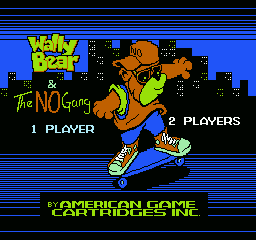Retro Replay Review
Gameplay
Wally Bear and the NO! Gang delivers an old‐school side-scrolling platformer experience that hinges on tight timing and level memorization. Players control Wally on his trusty skateboard, weaving through urban streets and suburban parks in a race against the clock. Each stage challenges you to dodge dive-bombing pigeons, leap over rabid bulldogs, and outmaneuver shady anthropomorphic characters pushing drugs or gang life. The core loop—skate, jump, bop—remains simple, yet it scales in difficulty as new hazards appear and the timer ticks down.
The game’s level layout rewards careful exploration: hidden power-ups grant temporary speed boosts or a more powerful skateboard swing, while secret pathways sometimes bypass clusters of enemies. Learning when to grind on a ramp versus when to stay grounded becomes critical, especially in later levels where the curfew deadline looms ever closer. Checkpoints are sparse, so a single mistake can send you back to the start, reinforcing the arcade-style challenge that defined many ‘90s platformers.
Controls are responsive, with Wally’s momentum feeling both fluid and weighty. Jump arcs offer a good margin for error, but the high-speed segments demand quick reflexes and precise timing. For younger players or newcomers, the initial levels serve as a forgiving tutorial, gradually introducing new enemy types and obstacles. Veteran gamers may find the later stages punishingly difficult, but that steep difficulty curve keeps the experience engaging for those who enjoy mastering patterns and shaving seconds off their runs.
Graphics
Visually, Wally Bear and the NO! Gang embraces the vibrant color palette of early console graphics, with cartoon-style sprites that pop against dynamic backdrops. The character art is charming if slightly dated, conveying Wally’s carefree attitude alongside the more menacing designs of drug dealers and gang members. Enemy animations are simple but effective—pigeons flap menacingly, bulldogs bark and lunge, and shady characters perform exaggerated gestures to lure Wally off his path.
Backgrounds shift from suburban sidewalks to graffiti-sprayed alleyways to industrial zones, each with distinct visual cues that help players anticipate upcoming obstacles. Parallax scrolling adds depth on supported hardware, lending a sense of motion that complements the skateboard motif. While the game doesn’t push the limits of 16-bit hardware, its consistent art style and clear visual hierarchy ensure that hazards never blend into the scenery.
Occasional graphical flourishes—like a brief flash when collecting a power-up or a small explosion when stomping an enemy—add polish without overwhelming the screen. These effects communicate important gameplay feedback, reinforcing the arcade roots of the title. Character portraits in story interludes are basic but endearing, enhancing the overall aesthetic and tying together the game’s anti-drug message with a friendly, cartoon vibe.
Story
At its heart, Wally Bear and the NO! Gang is an edutainment platformer with a clear mission: discourage children from drug use and gang affiliation. The plot unfolds simply—Wally’s invited to a party at his parents’ house, but his friends are scattered across town, each trapped in a dangerous scenario. Every level represents a different social hazard, from pushy dealers to pressure to join a gang, weaving the anti-drug theme directly into the gameplay challenges.
Storytelling is primarily delivered through brief text interludes and character portraits between levels. While the dialogue is sparse, it’s direct and age-appropriate, reminding players why they’re bopping enemies on the head rather than collecting coins. This straightforward approach lets the game maintain its pacing without tedious cutscenes, although players seeking a deeper narrative may find the plot skeletal.
Despite its didactic premise, the story remains engaging because it’s woven into the level design: every skid, jump, and skateboard swing has a purpose beyond mere obstacle navigation. The sense of urgency—beating curfew and rescuing each friend—gives Wally’s quest tangible stakes, turning textbook anti-drug messaging into an active gameplay incentive rather than a passive lecture.
Overall Experience
Wally Bear and the NO! Gang stands out as a quirky relic of ‘90s edutainment, offering solid platforming wrapped in an anti-drug message. Its blend of tight controls, varied obstacles, and a ticking clock creates a sense of urgency that keeps players engaged. While the graphics and audio adhere to the era’s limitations, they remain charming and functional, ensuring that gameplay always takes center stage.
The game’s educational angle won’t resonate with every modern player, but for families seeking a lighthearted introduction to platformers with a positive moral undercurrent, Wally Bear delivers. Replay value lies in perfecting your runs, uncovering all power-ups, and shaving seconds off the clock to rescue every friend before time runs out. Occasional difficulty spikes may frustrate younger gamers, but perseverance pays off with genuine satisfaction.
Overall, Wally Bear and the NO! Gang is a niche but worthwhile pick for collectors, retro gaming fans, or parents looking for an alternative to more violent platformers. It may not redefine the genre, but its earnest message, engaging level design, and classic side-scroll action secure its place as a memorable title from the golden age of educational console games.
 Retro Replay Retro Replay gaming reviews, news, emulation, geek stuff and more!
Retro Replay Retro Replay gaming reviews, news, emulation, geek stuff and more!








Reviews
There are no reviews yet.